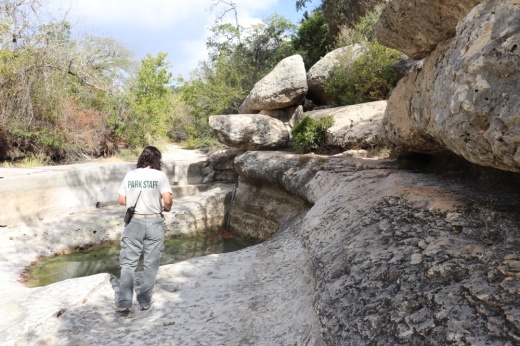Jacob’s Well, a popular spring-fed swimming area in Wimberley, has been closed for swimming by the Hays County Parks Department since August 2022 as low water levels and visibility deemed it unsafe. It stopped flowing for the fifth recorded time in history.
“A few months ago, we could tell Jacob’s Well had stopped flowing again,” said Katherine Sturdivant, Hays County parks education coordinator. “This is the longest extended period of zero flow that we have ever experienced.”
Two-minute impact
Central Texas was hit with a double threat this summer: record-breaking high heat and little rainfall. The region has seen temperatures over 100 degrees nearly every day since July 8, causing increased evaporation of local water reservoirs and increased wildfire risk.
Two main water regulatory agencies in the region, the Barton Springs Edwards Aquifer Conservation District and the Edwards Aquifer Authority, have recorded dropping water levels.
Entities such as the conservation district are dealing with unprecedented low water levels and “uncharted territory” as discharge from the Barton Springs dropped to 12 cubic feet per second, or cfs.
“The lowest flow that has ever been recorded for Barton Springs is 10 cfs in the drought of record, so we don’t really know what happens beyond there,” BSEACD Communications and Outreach Manager Shay Hlavaty said of the drought of record in the 1950s. “Barton Springs has never stopped flowing in recorded history.”
Canyon Reservoir in Comal County—which is one of the main water sources for various cities throughout Hays County—hit record lows Sept. 8 at 891.96 feet above sea level. The previous record was 892.7 feet in 2009.
Diving in deeper
As the region experiences rapid, persistent growth, water resources are in higher demand.
“The worst drought we ever had was in the 1950s, and Jacob’s Well did not stop flowing then,” Sturdivant said. “We had a third of the population in Central Texas at that time. Now, we have a similar drought but with three times as many people.”
Area cities have made changes over the past several years to diversify and conserve water. The city of Kyle completed its wastewater treatment plant expansion after years of planning and construction to increase the plant’s water treatment capacity.
In June, the city of Buda updated its drought ordinance to reduce water usage under certain stages.
“We changed our drought triggers to where, each stage, we basically cut in half the amount of available hours [residents] are allowed to water,” Buda Public Works Director Blake Neffendorf said.
To get ahead of the fluctuating water levels, San Marcos, Buda and Kyle have partnered with the Alliance Regional Water Authority to diversify their supplies of water through the Carrizo-Wilcox Aquifer.
What’s being done?
The Edwards Aquifer is a karst aquifer, which fills up quickly and runs out of water quickly, ARWA Executive Director Graham Moore said.
“The Carrizo[-Wilcox] Aquifer is very different. It’s like a big, thick beach sand aquifer,” Moore said. “It’s got water just in between all of that packed sand. It reacts very slowly to water being taken out of it.”
Many of the pipelines to connect the ARWA’s sources to cities across Hays County are under construction and expected to go live early next year.
While San Marcos entered Stage 4 out of 5 drought restrictions Aug. 27, as of Sept. 8, Buda is at Stage 2 of 4 and Kyle is in amended Stage 3 of 3.
What’s next?
Central Texas will need to see weeks of heavy rainfall—specifically near Fredericksburg—to end drought conditions, said Aaron Abel, water services manager for the Brazos River Authority. Warmer ocean temperatures from the El Niño effect could bring more rainfall in Texas, according to the National Weather Service.
“The good news about the El Niño, though, is that it will tilt our odds toward wetter conditions by the time we get into the winter time,” said Keith White, a meteorologist with the National Weather Service. “So we can hopefully start to make up some of those deficits.”






